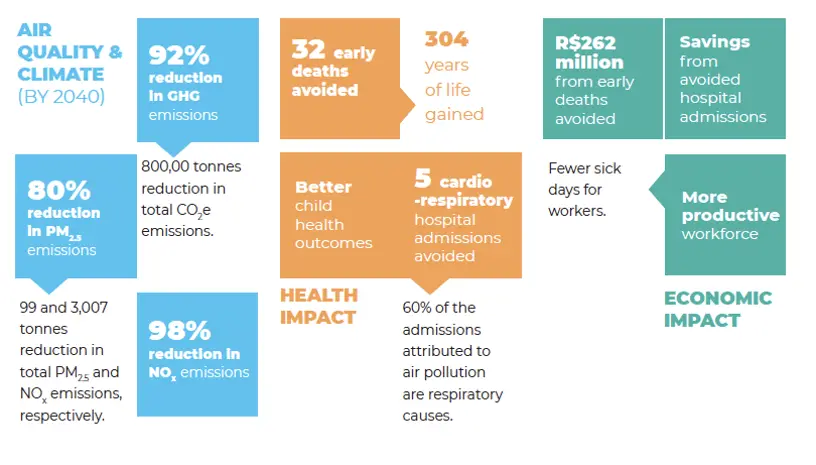
How data and integrated planning approaches can help cities fight air pollution
Poor air quality remains one of the greatest threats to the health and wellbeing of children and young people. We hear from Urban Shift, a UN-led programme, about how cities in Latin America are taking a data-driven approach to reducing pollution and promoting livability.
‘In Bogotá, Colombia, over 3,000 people die prematurely each year due to exposure to air pollution – namely from PM2.5, a fine particulate matter produced by vehicle exhaust, burning and industrial outputs. Bogotá is not alone.
According to 2021 data, of 174 cities in Latin America and the Caribbean, only 12 ( seven per cent) met the World Health Organization’s recommended guidance for PM2.5 levels, say Mariana Orloff and Eillie Anzilotti.
But Bogotá is also showing how data and integrated planning efforts can combat urban pollution and create more livable neighbourhoods. “In Bogotá, we have widespread issues around proximity,” said Freddy Grajales, Technical Lead for the City of Bogotá’s Strategic Environmental Secretariat. “In many areas, activities are separated, which results in long vehicle trips that contribute to pollution, congestion and crashes.”
To counteract these concerns, the city has adopted a “Barrios Vitales” strategy, a data-informed effort inspired by Barcelona’s Superblock model and Paris’ concept of a 15-minute city. Through this strategy, Bogotá is redesigning five neighbourhoods to centralize resources and encourage trips by foot and bike, subsequently reducing pollution and improving the health and wellbeing of residents.
The work underway in Bogotá is just one example of how cities in Latin America are combining data analysis with integrated planning approaches to reduce pollution and improve residents’ quality of life. On December 12, 2023, UrbanShift and WRI’s Air Quality program co-hosted a webinar on how Latin American cities are moving toward clean air for all. This work, said Beatriz Cardenas, Director of Air Quality at WRI México, is vital.
“When it comes to air quality, there are no borders,” she said. Even if the sources of pollution are localized, their impacts spread across the globe and create ripple effects: from global warming to respiratory and cardiovascular illness to diminished agricultural outputs. With a diverse panel of experts, the webinar dove into the importance of data for air quality work and how a strong analytical foundation can lead to projects with real impact.
In Mexico, the Guadalajara metropolitan area is the second most populous urban center and suffers from persistent high pollution levels and the increasing effects of climate change.
Determined to reduce pollution in the region, the Metropolitan Planning Institute for Guadalajara (IMEPLAN) collaborated with WRI México and the State of Jalisco to develop an integrated emissions inventory that identifies the sources of pollution in the region.
“This tool calculates and compiles estimates of emissions that are the most significant for improving air quality, reducing the contribution of global warming and managing pollutants in the atmosphere in an efficient and effective way,” said Ana Cecilia Perales, Technical and Administrative Coordinator of Air Quality for WRI México’s Cities program. “In this way, it is possible to identify and quantify the sources, develop regulations and track the impact of urban air quality interventions.”
Using this inventory as a baseline, WRI México evaluated how a new bus rapid transit (BRT) line in Guadalajara – Mi Macro Periférico, which runs 42 kilometers (about 26.1 miles) around the periphery of the city – impacts air quality. Through predictive modeling, Perales said, the team determined that if truck traffic were replaced with travel on the new BRT line (that uses buses with the latest EuroVI low-emission technology), the region could avoid about 27 pollution-related cardiovascular deaths and around 715 lost workdays in the year 2030. “This is a very practical example of how the inventory information could help us demonstrate the effectiveness of an urban intervention,” Perales said.
Local air quality forecasts foster transparency and accountability
The impacts of poor air quality are universal. As cities grapple with high rates of pollution -both from local sources like vehicle exhaust and from climate-related impacts like wildfires- it’s essential that they do what they can to inform and protect residents. Accurate data, said Sandra Meneses, Air Quality Coordinator with WRI Colombia, can offer residents up-to-date and actionable information about air quality in their cities, and help guide local interventions to mitigate high pollution levels.
CityAQ, a partnership between WRI, NASA Global Modeling and Assimilation Office and several cities including Addis Ababa, Bogotá, Jakarta, Kigali, León (Mexico), Monterrey, Guadalajara and São Paulo, uses emissions inventories, satellite imagery, local air quality data and machine learning to provide local air quality forecasts. “Participating cities can anticipate health-damaging pollution levels, communicate with stakeholders and manage local interventions more optimally and more effectively,” Meneses said.
Designing for Action and Impact
Integrated planning approaches that emphasize sustainable transportation options and resource proximity, like Bogotá’s Barrios Vitales initiative, are critical tools for cities aiming to reduce pollution. But it’s essential that they can quantify the benefits of these design approaches. In many Latin American cities, low-emission zones (LEZs) are garnering increased interest as a means to combat pollution, said Andrea Bizberg, Technical Advisor for C40’s Air Quality Climate Action Planning project in Latin America. LEZs are designated areas within cities that impose stricter regulations to limit transport-related emissions through, for example, restricting high-emitting vehicles or limiting through traffic. While effective, LEZs often attract pushback, Bizberg said. “We know with these LEZs, one of the main priorities is communicating the benefits of the project well to build support and achieve successful implementation.”
C40 Cities developed a new tool, Air Quality through Urban Actions (AQUA), which enables city staff to easily calculate the benefits of air quality interventions, informed by population, exposure, health and economic cost data in addition to epidemiologic evidence. As Rio de Janeiro was planning for a low-emission district, they used AQUA to calculate the benefits of creating an electric-vehicle-only district in the city.
By 2040, the payoff for the city and its residents would be pronounced: emissions would decline by around 80 per cent, residents’ health outcomes would improve and the city would save millions from avoided health impacts and increased productivity. “With this base analysis, the city could, as a next step, put together a communication campaign built around these results to create buy-in,” Bizberg said.

Improving air quality is at the heart of UrbanShift’s approach. Each one of the initiative’s core focus areas—from nature-based solutions to integrated planning—are integral to efforts at the local and global scale to improve air quality. Urban greening makes a difference, as does fleet electrification and creating walkable and bikeable communities. The data and tools shared in our recent webinar are essential resources for cities undertaking multifaced approaches to create clean air for all.
Learn more about UrbanShift’s work with cities in its 2022-2023 Annual Report and explore how WRI and C40 Cities are working to improve air quality not only in Latin America, but across the globe.
This article originally appeared on ShiftCities.org, part of the World Resources Institute
Mariana Orloff is Senior Manager for Urban Development at WRI Ross Center for Sustainable Cities.
Eillie Anzilotti is Communications Lead for UrbanShift at WRI Ross Center for Sustainable Cities.




